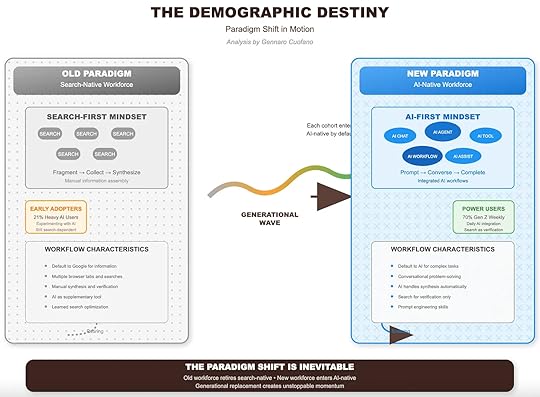The Demographic Destiny, The Paradigm Shift in Motion

Technological revolutions don’t spread evenly. They cascade through society along demographic lines, with adoption patterns shaped less by features and more by generational mindset. What we are witnessing today is not just the rise of AI as a tool — it’s the generational replacement of a search-native workforce by an AI-native workforce.
That transition is destiny. Each cohort entering the workforce now arrives with AI-first reflexes, while older cohorts, shaped by decades of search-based workflows, gradually retire. This demographic shift ensures the paradigm transition is inevitable, regardless of short-term corporate hesitation.
From Search-First to AI-FirstThe old paradigm was defined by a search-first mindset. Workers defaulted to Google for information, stacking multiple tabs, refining queries, and manually synthesizing answers. Productivity depended on individual skill at navigating the search ecosystem: writing good queries, cross-checking results, and assembling fragments into coherent insights.
Workflow Characteristics of the Search-Native Era:Fragmented information collectionManual synthesis and verificationLearned search optimization as a key skillAI as a supplementary, experimental toolEven early adopters of AI within this paradigm (roughly 21% of heavy AI users) remained search-dependent, using AI experimentally but falling back on Google for validation and reliability.
Contrast this with the new paradigm: the AI-native workforce. For these cohorts, AI is not a supplement but the default. Search exists only as a backstop — a verification tool when needed.
Workflow Characteristics of the AI-Native Era:Default to AI for complex tasksConversational problem-solving through chat interfacesAutomatic synthesis built into workflowsSearch used for verification, not discoveryPrompt engineering and orchestration as learned skillsThis shift isn’t about preferences. It’s about habits formed during formative years. Gen Z power users already show that over 70% engage with AI weekly, and for them, “search” is no longer the starting point.
The Generational WaveGenerational transitions work like tides. They don’t need permission, and they don’t reverse. The search-native workforce is retiring while the AI-native workforce is entering by default.
This wave has three important consequences:
Adoption Is InexorableEven if enterprises resist, the workforce itself shifts the balance.Organizations slow to adopt AI will be forced to catch up as younger employees bring AI-first workflows to every role.Search Optimization Loses ValueDecades of learned skill in query crafting, SEO strategies, and manual synthesis erode in relevance.Efficiency no longer comes from finding the best link — but from framing the best prompt.Cultural Reset in WorkflowsWork is no longer about hunting for fragments but conversing toward completion.Tasks collapse from fragmented sequences into integrated AI workflows.The demographic shift guarantees that resistance to AI adoption is temporary. What looks like experimentation today becomes cultural default tomorrow.
Why Organizations Underestimate the ShiftMany executives misjudge this transformation because they focus on technology readiness rather than demographic inevitability.
Technology Readiness View:“We’ll adopt AI when the tools are proven, secure, and fully ROI-positive.”Demographic Destiny View:
“Whether or not leadership is ready, the incoming workforce is already AI-native.”
The result is a strategic blind spot. By waiting for clarity, companies risk creating friction between AI-native employees and legacy processes. This generational mismatch slows productivity and creates frustration, especially as younger cohorts bring their own tool stacks into the workplace.
Search as Verification, Not DiscoveryThe most profound shift is the repositioning of search itself. In the AI-native paradigm, search no longer leads the workflow. Instead, it becomes a verification layer.
Search-native mindset: Search → Collect → SynthesizeAI-native mindset: Prompt → Converse → Complete → VerifyThis inversion erodes the economic foundation of the open web. If discovery no longer starts in search, then publishers lose visibility and search engines lose their monopoly on workflow initiation.
For organizations, this means SEO as a growth lever will steadily decline. The real leverage moves to AI visibility: how, when, and where your brand appears in AI-mediated interactions.
Implications for StrategyThe demographic destiny reframes how companies must think about transformation:
Workflow RedesignInstead of bolting AI onto legacy processes, redesign work around AI-native behaviors.Optimize for conversational inputs, real-time synthesis, and agent orchestration.Skill ShiftsSearch optimization fades, while prompt design, context engineering, and agent orchestration rise as core skills.Training programs must reflect this, shifting investment away from “search literacy” to “AI fluency.”Competitive DifferentiationCompanies that align early with AI-native workflows will attract and retain AI-native talent.Those that cling to search-native systems will find themselves outpaced not just technologically, but demographically.Long-Term Cultural AdvantageJust as digital-native firms (born in the internet era) outcompeted analog incumbents, AI-native firms will structurally outperform search-native laggards.The cultural reflex of “AI-first” becomes a built-in speed and productivity advantage.The Inevitable TransitionThe paradigm shift is not a matter of if but when. Old workflows were built on fragmented search, manual verification, and tab sprawl. New workflows are built on conversational AI, automatic synthesis, and verification-on-demand.
The driver isn’t just technological capability — it’s demographic inevitability. Each new cohort enters the workforce AI-native by default.
Executives who understand this will frame AI transformation not as a tech rollout, but as a generational alignment strategy. Those who don’t will find their organizations slowly dissonant with the very people they hire.
The Bottom LineThe search-native era defined two decades of work. But just as the typewriter yielded to the computer, the search box is yielding to the AI interface.
What accelerates this transition is not adoption curves alone — it’s demographics. As the old workforce retires and the new workforce enters, the AI-native mindset becomes cultural default.
The paradigm shift is inevitable. The only question is whether organizations will adapt deliberately — or be dragged into the future by the demographic wave already in motion.

The post The Demographic Destiny, The Paradigm Shift in Motion appeared first on FourWeekMBA.



